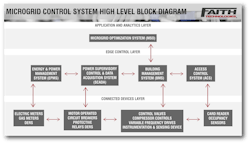As energy solutions continue to evolve, the benefits of microgrids and their ability to provide reliable sources of electricity have come to the forefront of many business leaders’ minds. At the research and development microgrid at the Bubolz Nature Preserve in Appleton, Wis., for example, there are multiple connected sources of power generation called distributed energy resources (DERs) that can operate the facility apart from the local electric utility. But why talk about microgrids in an article about connected buildings? A microgrid is not only a quantity of DERs connected to a quantity of electrical loads; it is also a highly complex, integrated control system, much like a connected building.
If we closely examine the Bubolz microgrid control system, it can be broken down in a hierarchy consisting of three layers, referred to as a technology stack. At the top of the control system is the applications and analytics layer of the technology stack, containing a microgrid optimization system (MOS), which is typically a cloud-based solution that develops control strategies for which DER will operate when and how. The optimization system compares factors such as utility rate structures, weather predictions, costs of fuel, and requirements for heating or cooling to determine the best use case for operation. Then it sends control logic commands to the next layer of the technology stack: the edge control layer.
At Bubolz, there are four systems that make up the edge control layer of the technology stack, each with its own control and management responsibility. It’s important to note that the edge control systems communicate not only up to the MOS but also across each of these systems.
- Energy & Power Management System (EPMS): Aggregates all electrical and the balance of the WAGES (water, air, gas, electricity and steam) metering data as well as electrical distribution system operational parameters.
- Electrical Distribution System Supervisory Control and Data Acquisition (SCADA): Control system that physically operates the electrical control system based on programable control logic, and will open/close circuit breakers, protective or utility interlock relaying systems as required for the current operating parameters.
- Building Management System (BMS): Operates and manages the mechanical/HVAC systems of the facility.
- Access Control System (ACS): Provides the physical security for the facility.
At the bottom of the Bubolz technology stack are the connected devices, which consist of all the operable equipment and instrumentation in the system, such as motor-operated circuit breakers, protective relays, operable valves, metering equipment, inverters, DERs, and HVAC systems, etc. The connected devices are all controlled by edge-control layer software. A high-level sequence of operation for one possible use case for Bubolz microgrid system operation would be something like this:
The MOS reviews the long-term weather forecast and sees a high likelihood of severe thunderstorms and high winds. In preparation for storm conditions, the MOS sends commands to route excess photovoltaic generation capacity to the storage battery system to ensure that battery is fully charged, instead of sending that excess energy to the utility. The MOS also reviews current energy consumption of the facility and determines if additional DERs need to be brought online in standby mode ready to receive load. It then sends commands to the various edge control systems to implement the requested control sequences.
In the scenario above, the photovoltaic generation capacity would be metered via the EPMS, then apportioned and routed to the proper location via the SCADA system, which would implement the decision to open utility islanding relays to disconnect the microgrid from the utility network. The BMS system would interact with the EPMS and operate the facility physical plant in conformance with available electrical generation capacity. If the facility is operating in islanded mode with no connection to the utility, the facility operation must be limited to the onsite available generating capacity. If energy generation is limited, the BMS may have to adjust the building temperature (less warm in winter/less cool in summer) if there is a limited supply of energy to support electric heating/cooling equipment. Further integrating the ACS into the control strategy allows for operational control based on the occupancy of the building or what the occupant status is, such as peak operational time versus a closed facility or limited staff. If a utility outage would happen late in the evening, the MOS (in conjunction with the EPMS, SCADA and BMS systems) will provide a different sequence of operation if the ACS indicated that the building is unoccupied.
Just remember that a microgrid is fundamentally an interconnected and interoperable connected building control system. The interconnection between all three layers of the technology stack is required for successful operation of the system.
About the Author
Jason Heindel
Heindel is a former solutions architect for Faith Technologies’ connected buildings team. He analyzes, designs, implements and manages smart building projects with an emphasis on client business solutions, project management and data system integration. He is now a solutions architect with AZZO.

